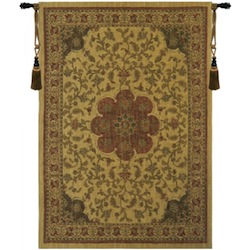When most people think about “decorating”, they think of accent pieces like small furniture, or paintings. Yet “textile art” is another idea that you can use to showcase artistic tastes in your home. Wall tapestries are one of these types of art. Wall tapestries can be purchased new, or as antiques. If you are buying new, then a tremendous variety of styles and sizes are available to you; and if you have the budget, you can even design your own tapestry and have it made.
Tapestries that are used primarily as an art piece need to have good natural or track lighting and be placed prominently in a room or hallway. Generally, the wall tapestry should have enough empty space around it to augment its role as a signature piece in the room. Wall tapestries are traditionally hung on a rod and displayed, but you can also have your tapestry mounted on a lightweight board and hung if you prefer. If you like, you can frame a tapestry, but whether this is the best showcase option will depend on the tapestry, and how much you do not mind losing the look of texture behind glass.
Wall tapestry art is best placed where you will enjoy it the most. If you have a home-office where you spend countless hours, this is likely the best place to hang a wall tapestry. Homes with open floor plans are great for tapestry wall art because they can be hung in one room, but enjoyed from another. The purpose of wall tapestry art is that it be studied and enjoyed. The traditional places of over the mantel and in stairwells are not bad ideas as long as your tapestry will have many opportunities to speak to you throughout the day and evening.

